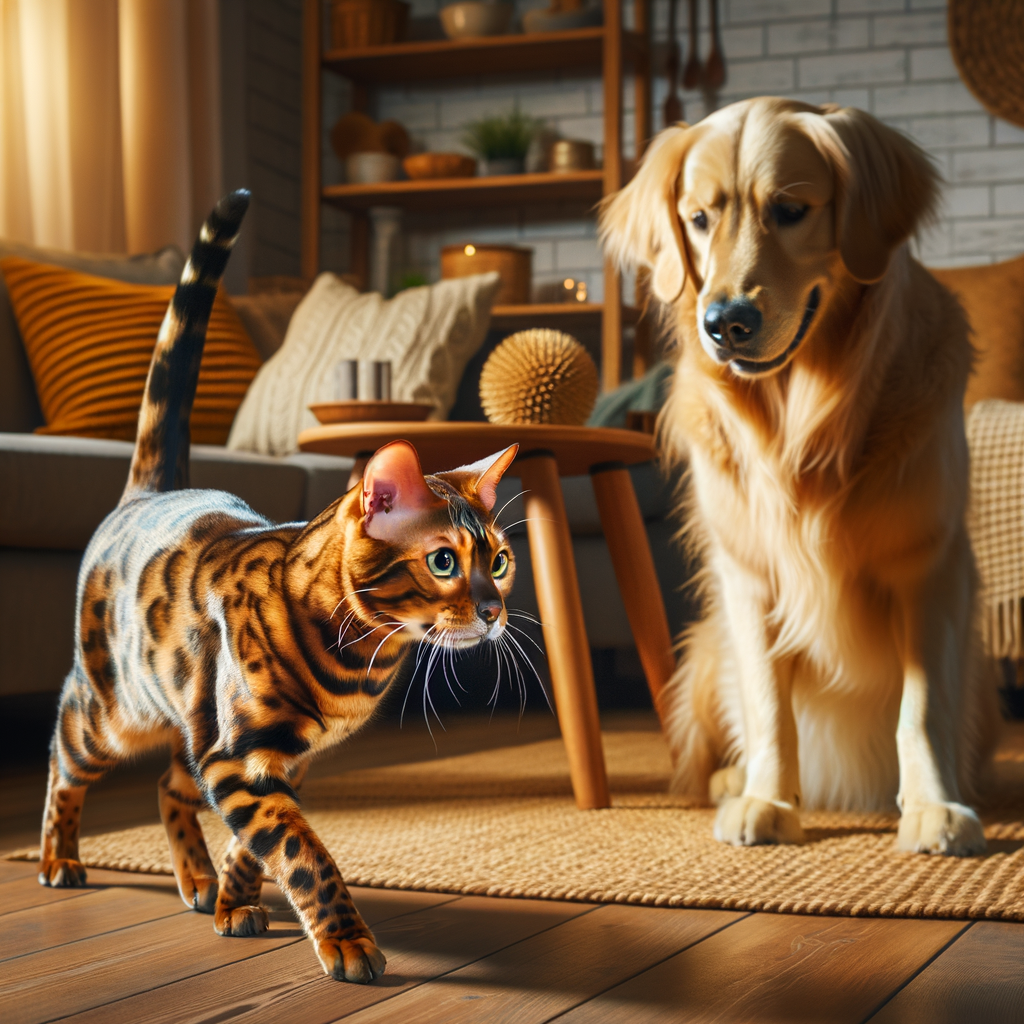
Introduction: Bengal Cat and New Pet Introduction
Introducing a Bengal cat to a new pet can be a rewarding experience. However, it requires careful planning and patience. In this section, we will discuss why proper introductions are important and some common challenges you might face.
- The importance of proper introduction: A well-planned introduction helps ensure that both pets feel safe and comfortable. It can prevent stress and aggression, leading to a harmonious relationship.
- Common challenges in introducing a Bengal cat to a new pet: Bengal cats are known for their high energy and curiosity. They might feel threatened by a new pet, leading to territorial behavior. Additionally, differences in species, such as introducing a Bengal cat to a dog, can add complexity to the process.
Bengal Cat Socialization Tips
Preparation for New Pet and Bengal Cat Interaction
-
Creating a safe space for both pets
- Separate Areas: Set up separate areas in your home where each pet can retreat and feel secure.
- Comfort Items: Provide familiar items like toys, blankets, and beds to make the spaces cozy.
- Gradual Introduction: Allow the pets to get used to each other’s scent by swapping bedding or toys before a face-to-face meeting.
-
The behavior and temperament of Bengal cats
Behavior Description Playfulness Bengal cats love to play and need plenty of stimulation. Curiosity They are very curious and enjoy exploring their environment. Intelligence Bengal cats are smart and can learn new tricks quickly.
Initial Introduction
- How to introduce the new pet to the Bengal cat:Introducing a new pet to your Bengal cat should be done carefully. Start by keeping the new pet in a separate room. Let them get used to each other’s scent by swapping bedding or toys. This helps them become familiar with each other without direct contact.
After a few days, allow them to see each other through a baby gate or a cracked door. This way, they can observe without feeling threatened. Gradually increase the time they spend seeing each other.
- Monitoring the first interaction:When it’s time for the first face-to-face meeting, keep it short and supervised. Watch their body language closely. Signs of aggression or fear should be addressed immediately by separating them and trying again later.
Provide treats and praise to both pets for calm behavior. This positive reinforcement helps them associate each other with good experiences.
Progressive Socialization
- Gradual increase in interaction time: Start by letting your Bengal cat and the new pet see each other from a distance. Gradually, allow them to spend more time together. Begin with short sessions and slowly increase the duration. This helps them get used to each other without feeling overwhelmed.
- Encouraging positive behavior: Reward both pets for calm and friendly behavior. Use treats and praise to reinforce good interactions. This makes them associate each other with positive experiences. Over time, they will learn to coexist peacefully.
Bengal Cat and Dog Introduction
-
Specific tips for introducing a Bengal cat to a dog:
- Start Slowly: Keep the cat and dog in separate rooms at first. Let them get used to each other’s scent by swapping bedding or toys.
- Use a Barrier: Use a baby gate or a screen door to allow them to see each other without direct contact.
- Supervised Meetings: When they first meet, keep the dog on a leash and the cat in a carrier. This helps control the situation.
- Positive Reinforcement: Reward both pets with treats and praise when they behave calmly around each other.
- Short Sessions: Keep initial meetings short and gradually increase the time they spend together.
-
The dynamics between cats and dogs:
- Natural Instincts: Dogs are often more social and may see the cat as a playmate. Cats, on the other hand, can be more territorial.
- Body Language: Learn to read their body language. A wagging tail in a dog can mean excitement, but in a cat, it can mean irritation.
- Patience is Key: It may take time for them to adjust to each other. Be patient and don’t rush the process.
- Safe Spaces: Ensure your Bengal cat has high places to retreat to, like shelves or cat trees, where the dog can’t reach.
- Consistency: Maintain a consistent routine to help both pets feel secure and understand what to expect.
How to Socialize Bengal Cat with New Pet
Dealing with Aggression
- Identifying signs of aggressionLook for signs like hissing, growling, and swatting. They might also puff up their fur or arch their back. These are clear signals that your cat is not comfortable.
- How to handle aggressive behaviorIf your Bengal cat shows aggressive behavior, stay calm. Do not yell or punish them. Instead, give them space and time to cool down. You can also try to distract them with a toy or treat. Gradually, they will learn to feel safe around the new pet.
Building Trust
-
Encouraging Trust-Building Activities
Start with simple activities. For example, let them sniff each other’s toys. This helps them get used to each other’s scent.
Another great activity is feeding them in the same room but at a distance. This shows them that sharing space is safe. Gradually, you can move their bowls closer together.
Use interactive toys like feather wands or laser pointers. This can help them bond over fun activities.
-
Importance of Patience in Building Trust
It can take weeks or even months for pets to feel comfortable with each other. Don’t rush the process. Each pet has its own pace. Some may take longer to adjust. Respect their timelines and give them space when needed.
New Pet Introduction for Bengal Cats
- Role of the new pet in the introduction process
When introducing a new pet to your Bengal cat, it’s important to understand the role the new pet will play. Will they be a companion, playmate, or just another member of the household? Knowing this helps set the right expectations and plan the introduction accordingly.
-
- The new pet’s behavior and temperament
Each pet has its own unique behavior and temperament. For example, dogs may be more energetic and playful, while other cats might be more reserved. Observing the new pet’s behavior can help you anticipate how they will interact with your Bengal cat.
Bengal Cat and New Pet Bonding
Shared Activities
- Creating opportunities for shared activities
When you bring a new pet into your home, create opportunities for shared activities. This helps your Bengal cat and the new pet get to know each other. Simple activities like playing with toys, eating together, or even just sitting in the same room can make a big difference. These shared moments can help build trust and friendship between your pets.
- Monitoring and encouraging positive interactions during shared activities
Watch for signs of stress or aggression, and be ready to step in if needed. Encourage positive interactions by rewarding good behavior with treats or praise. This helps reinforce the idea that being together is a good thing. Over time, your Bengal cat and new pet will likely become more comfortable and friendly with each other.
Introducing Bengal Cat to Other Pets
-
Specific tips for introducing a Bengal cat to other types of pets
-
- Start Slow: Allow your Bengal cat and other pets to get used to each other’s scent before any face-to-face meetings. You can do this by swapping their bedding or using a cloth to transfer scents.
- Supervised Meetings: When you first introduce them, make sure the meeting is supervised. Keep the initial interactions short and gradually increase the time they spend together.
- Safe Spaces: Ensure that both your Bengal cat and the other pets have their own safe spaces where they can retreat if they feel overwhelmed.
- Positive Reinforcement: Use treats and praise to reward calm and friendly behavior. This helps create positive associations with each other.
- Patience: Every pet is different. Some may take longer to adjust than others. Be patient and give them time to get comfortable with each other.
-
-
The dynamics between cats and other pets
- Territorial Nature: Cats, including Bengals, can be territorial. They may see new pets as intruders. Gradual introductions help reduce territorial stress.
- Body Language: Pay attention to body language. A relaxed cat will have a calm demeanor, while a stressed cat may hiss, arch its back, or hide.
- Different Species, Different Behaviors: Dogs, birds, and small mammals all have different ways of communicating. Understanding these differences can help you mediate interactions better.
- Hierarchy Establishment: Pets often establish a hierarchy. Allow them to work out their social structure naturally, but intervene if any pet becomes aggressive.
Bengal Cat and New Pet Coexistence
-
Long-term Strategies for Peaceful Coexistence
- Separate Spaces: Initially, keep your Bengal cat and new pet in separate areas. This helps them get used to each other’s scent without direct contact.
- Gradual Introduction: Slowly introduce them to each other. Start with short, supervised meetings and gradually increase the time they spend together.
- Positive Reinforcement: Reward both pets with treats and praise when they show calm behavior around each other. This encourages positive associations.
- Safe Zones: Ensure each pet has a safe space they can retreat to if they feel stressed. This could be a separate room or a cozy bed.
- Monitor Interactions: Always supervise their interactions until you are confident they can be trusted alone together.
-
Case Studies of Successful Bengal Cat and New Pet Coexistence
Many families have successfully introduced Bengal cats to new pets. Here are a few examples:
-
- Case Study 1: Sarah’s Bengal Cat and Labrador
Sarah introduced her Bengal cat, Leo, to her Labrador, Max. She used gradual introductions and positive reinforcement. Within a few weeks, Leo and Max were playing together and even napping side by side.
-
- Case Study 2: Tom’s Bengal Cat and Parrot
Tom was worried about introducing his Bengal cat, Bella, to his parrot, Polly. He started by keeping them in separate rooms and slowly introduced them through a glass door. Over time, Bella and Polly became comfortable with each other, and now they coexist peacefully.
-
Successful Bengal Cat and New Pet Introduction
-
Recap of Key Takeaways
- Socialization is Key: Start by letting your Bengal cat get used to the new pet’s scent.
- Gradual Introductions: Allow short, supervised meetings between the Bengal cat and the new pet.
- Positive Reinforcement: Reward both pets with treats and praise for good behavior.
- Monitor Interactions: Always keep an eye on their interactions to ensure safety.
-
Final Tips for Successful Introduction
- Be Patient: Every pet is different, and some may take longer to adjust.
- Provide Separate Spaces: Ensure each pet has its own space to retreat to if needed.
- Consistency: Stick to a routine to help both pets feel secure.
- Seek Professional Help: If you encounter issues, consider consulting a pet behaviorist.






